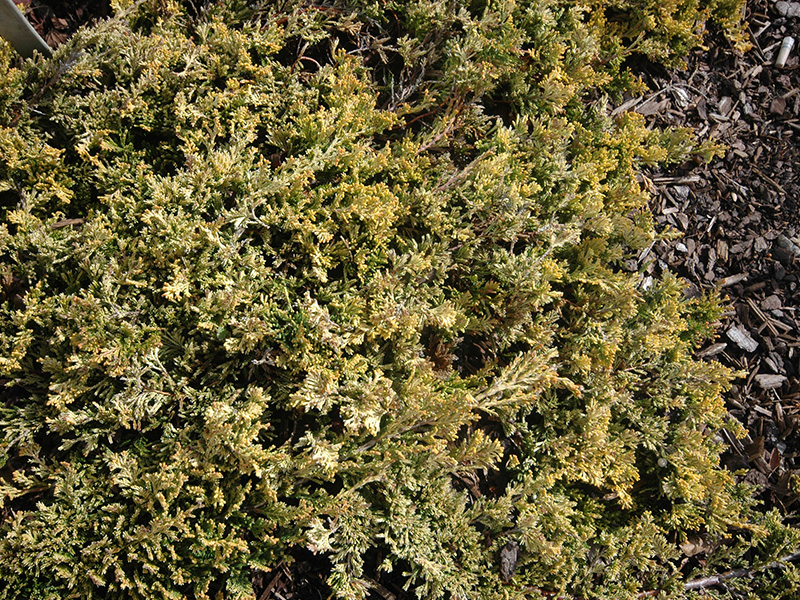
Woody > Juniperus > Juniperus horizontalis > Juniperus horizontalis 'Mother Lode'
Juniperus horizontalis
'Mother Lode'
Mother Lode Juniper
Origin: It was introduced by Iseli Nursery in 1982 and is a sport of J. horizontalis 'Wiltonii'.
Mike's
Opinion


"
An unusual plant in that it is low growing, intense yellow-gold colour yet manages to survive winters with little or no burn.
Michael Pascoe, NDP., ODH., CLT., MSc. (Plant Conservation)
"
| Family |
| Cupressaceae |
| Genus |
| Juniperus |
| Species |
| horizontalis |
| Cultivar |
| 'Mother Lode' |
| Category |
| Woody |
| Type |
| Shrub (evergreen) |
| Synonyms |
| Juniperus horizontalis 'Golden Carpet' |
| Pronunciation |
| USDA Hardiness Zone |
| 3 - 9 |
| Canadian Hardiness Zone |
| 1a - Requires cool season protection under glass. |
| RHS Hardiness Zone |
| H4 - H7 |
| Temperature (°C) |
| -40 - (-1) |
| Temperature (°F) |
| -40 - 30 |
| Height |
| 7 - 15 cm |
| Spread |
| 2.5 - 3 m |
Photographs
Description and Growing Information
Flowering Period
| General Description |
| This specimen is a sport of Juniperus horizontalis 'Wiltonii'. It's a slow growing, spreading cultivar. Its feather-like branches are bright yellow and have a soft texture. The under-branching is bright green. |
| Landscape |
| Valued for is tolerance to many different soil types and climate conditions. Used as an accent plant and as a groundcover, however it is not as vigorous as the blue and green cultivars of J. horizontals in such situations. |
| Cultivation |
| Mother Lode is an adaptable plant thriving in full to partial shade and full sun but with the possibility of some winter burn in the later. It prefers well-drained soil but is adaptable to hot dry situations once established. |
| Shape |
| Prostrate, low growing and horizontally spreading. |
| Growth |
| Slow |
| ID Characteristic |
| Mother Lode has a very bright golden yellow foliage colour and is flat, low growing groundcover with long trailing branches. It will turn a vibrant orange in the autumn. |
| Pests |
| Juniper blight (Phomopsis) and spider mites may be a problem. |
| Habitat |
| Horticultural origin. |
| Bark/Stem Description |
| Gray brown and lightly ridged and furrowed, but is barely visible due to the deinstiy of the foliage. |
| Flower/Leaf Bud Description |
| Buds are inconspicuous, 1.5 mm long and sharply pointed. |
| Leaf Description |
| Ovate to oblong feathery-like soft textured leaves. Shortly pointed leaves with a glandular depression on the back and with awl shaped leaves in opposite pairs. |
| Flower Description |
| Dioecious, and inconspicuous. Male flowers: united ovid or on oblong catkin. Female flower: 3 - 8 valvate scales, some or all bearing 1 - 2 ovules. Scales become fleshy and unite into a berry like cone in the spring. |
| Fruit Description |
| Cones are bluish or greenish black, 2.5-3.5 mm long and contain 2-3 seeds which are slightly glaucous. |
| Colour Description |
| Bright yellow-green in the summer turning to a vibrant orange tinged with purple in the autumn, maintaining its colour throughout the winter. Under-branching is bright green. |
| Texture Description |
| Medium to fine. The foliage is not prickly and leans more towards the fine side of the spectrum. |
| Notable Specimens |
| The Gardens of Fanshawe College (M building), London, Ontario, Canada. |
| Propagation |
| By hardwood cuttings in early to mid-winter, rooted in sand or perlite under mist with bottom heat. |
